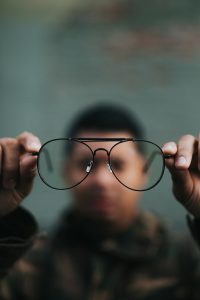17 Coaching Self-Regulated Learners
Lynn Meade

A Change of Perspective May Be Needed
Now and then a conversation comes your way that changes the way you think about things. In my case, it was a conversation with an athletic academic coach. He was in my office seeing what he could do to help a failing student-athlete prepare for his upcoming assignment. A colleague overheard the conversation and was very upset by what she perceived as special treatment. She let that coach know that many good students on campus didn’t get special help, nor did they require it.
I felt the tension of the conversation and honestly felt trapped in the middle of an uncomfortable confrontation. It was tense, but I am so glad I was there. I’m glad I was there to hear this life-changing reply.
The academic coach said, “I know some of our students come in ill-prepared. Some come from inner-city schools where they have had to fight to survive, others come from rural districts where their schools didn’t provide the rigor they need to be ready for college.” He continued, “I can’t help how they got here, where they came from, or what they know, what I can do is to do my best to give them every opportunity to learn why they are here.”
The message is so important. We can’t change where our students come from or what they did or didn’t learn in high school, but now that they are here, we can help them learn how to learn. Since you are a coach, you are likely already on board with the idea of coaching students to learn, but you may find resistance from other faculty, administrators, and surprisingly from the students you coach.
Shaping Our Students to Become Self-Regulated Learners
One of our goals as coaches should be to help students become self-regulated learners. Self-regulated learning refers to one’s ability to understand and control one’s learning environment. Students who become self-regulated learners learn more in a course, experience a greater depth of thinking, and consequently have higher performance scores. Because they experience college successes, they tend to have increased self-esteem and a stronger belief that they can do hard things in the future.
Three Phases of Self-Regulated Learning
There are three main parts to becoming a self-regulated learner. These are forethought, performance, and reflection and you will learn about each of these.
- Forethought: A student thinks about the task ahead, sets goals, and has a plan for how to accomplish those. Rolled into this is a student’s motivation to learn and their belief in the value of learning.
- Performance: A student tests out different learning strategies.
- Reflection: A student evaluates one’s prior performance and one’s future performance and makes adjustments.
Learning Objectives
This unit is broken into three subtopics, at the end coaches will be able to…
- Identify and leverage intrinsic and extrinsic motivations for learning
- Describe the Pomodoro technique and its structure of focused work periods followed by intentional breaks.
- Describe the impact of visible cell phones on cognitive performance.
- Explain distributed retrieval practice (spaced repetition) and how it enhances learning outcomes.
- Explain the benefits of spaced repetition.
- List strategies that are most effective for active retrieval practice.
- Implement strategies that encourage students to actively reconstruct material from memory, engage in discussions, and apply knowledge to new situations.
- Describe the role of sleep in preparing the brain for learning and memory consolidation.
- Explain self-reflective learning to include forethought, performance, and reflection.
- Ask questions to help students reflect on the cognitive, affective, and behavioral dimensions of learning.
- Discuss attribution error and its impacts on taking responsibility for learning.
References
Baldwin, A. (2020). College success. OpenStax.
Brown, A. (1987). Metacognition, motivation, and understanding. In F. E. Weinert & R. H. Kluwe (Eds.), Metacognition, motivation, and understanding (pp. 65-116). Lawrence Erlbaum Associates.
Cooper, M. M., & Sandi-Urena, A. (2009). Design and validation of an instrument to assess metacognitive skillfulness in chemistry problem-solving. Journal of Chemical Education, 86(2), 240-245.
Cooper, M. M., & Sandi-Urena, S. (2008). Design and validation of an instrument to assess metacognitive skillfulness in chemistry problem-solving. Chemistry Education Research and Practice, 9(1), 18-24.
Flavell, J. H. (1976). Metacognitive aspects of problem-solving. In L. B. Resnick (Ed.), The nature of intelligence (pp. 231-236). Erlbaum.
Leamonson, R. (n.d.). Learning your first job.
Nilson, L. B. (2013). Creating self-regulated learners: Strategies to strengthen students’ self-awareness and learning skills. Stylus.
O’Grady, P. (2012). The Twitter generation: Teaching deferred gratification to college students. National Teaching and Learning Forum, 21(3), 6-8.
Rickey, D., & Stacy, A. M. (2000). The role of metacognition in learning chemistry. Journal of Chemical Education, 77, 915-920.
Schraw, G. (1998). Promoting general metacognitive awareness. Instructional Science, 26(1-2), 113-125.
Sousa, D. A. (2011). How the brain learns (4th ed.). Corwin Press.
Teaching Excellence and Adult Literacy. (n.d.). Teal Center Fact Sheet No. 3: Self-regulated learning. [Note: Missing publisher and URL]
University of Pittsburgh. (n.d.). Time management calculator.
Zimmerman, B. J., & Schunk, D. H. (2001). Self-regulated learning and academic achievement: Theoretical perspectives. Lawrence Erlbaum Associates.
Media Attributions
- nathan-dumlao-VJHb4QPBgV4-unsplash © Nathan Dumlao is licensed under a CC BY (Attribution) license

